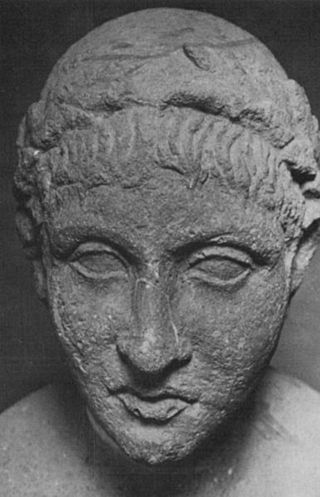The 250s was a decade that ran from January 1, 250, to December 31, 259.
This article concerns the period 149 BC – 140 BC.
This article concerns the period 159 BC – 150 BC.
Lucius Aemilius Paullus Macedonicus was a consul of the Roman Republic, as well as a general, who conquered the kingdom of Macedonia during the Third Macedonian War.

Lucius Aemilius Paullus, also spelled Paulus, was a consul of the Roman Republic twice, in 219 and 216 BC. He is primarily remembered for being one of the commanders of the Roman army at the Battle of Cannae, and for his death in the same battle.

Publius Cornelius Scipio Africanus Aemilianus, known as Scipio Aemilianus or Scipio Africanus the Younger, was a Roman general and statesman noted for his military exploits in the Third Punic War against Carthage and during the Numantine War in Spain. He oversaw the final defeat and destruction of the city of Carthage. He was a prominent patron of writers and philosophers, the most famous of whom was the Greek historian Polybius. In politics, he opposed the populist reform program of his murdered brother-in-law, Tiberius Gracchus.

The gens Aemilia, originally written Aimilia, was one of the greatest patrician families at ancient Rome. The gens was of great antiquity, and claimed descent from Numa Pompilius, the second King of Rome. Its members held the highest offices of the state, from the early decades of the Republic to imperial times. The Aemilii were almost certainly one of the gentes maiores, the most important of the patrician families. Their name was associated with three major roads, an administrative region of Italy, and the Basilica Aemilia at Rome.
Aemilia Lepida is a Latin feminine given name that was given to the daughters of various Aemilius Lepiduses, men belonging to the Lepidus branch of the Aemilia gens (family) that was founded by the Marcus Aemilius Lepidus who served as consul in 285 BC. The Aemila Lepidas who appear in Roman historians were principally known for their engagements and marriages, with those in the late Republic and early Empire related to the Julio-Claudian dynasty.
Cornelia was the daughter of Scribonia and her second husband. She was stepdaughter to Octavian through her mother's third marriage and half-sister to Julia the Elder, Augustus' only biological child.

The gens Cornelia was one of the greatest patrician houses at ancient Rome. For more than seven hundred years, from the early decades of the Republic to the third century AD, the Cornelii produced more eminent statesmen and generals than any other gens. At least seventy-five consuls under the Republic were members of this family, beginning with Servius Cornelius Maluginensis in 485 BC. Together with the Aemilii, Claudii, Fabii, Manlii, and Valerii, the Cornelii were almost certainly numbered among the gentes maiores, the most important and powerful families of Rome, who for centuries dominated the Republican magistracies. All of the major branches of the Cornelian gens were patrician, but there were also plebeian Cornelii, at least some of whom were descended from freedmen.
Gaius Livius Drusus was a Roman politician who was consul in 147 BC, together with Scipio Aemilianus.
Quintus Fabius Maximus Allobrogicus, was a Roman statesman and general who was elected consul in 121 BC. During his consulship he fought against the Arverni and the Allobroges whom he defeated in 120 BC. He was awarded a triumph and the agnomen Allobrogicus for his victory over the Gauls.
Quintus Fabius Maximus Aemilianus was a Roman statesman and consul.
Aemilia Tertia, properly Aemilia, was the wife of Scipio Africanus.
Publius Cornelius P.f. P.n. Scipio was the eldest son of Scipio Africanus and his wife Aemilia Paulla. He was chosen augur from 180 BC. Little information on him survives, as he did not stand for any of the high offices or have a public career of note. Cicero relates that he was in poor health, the particulars of which he refuses to mention, stating that "we ought not to reproduce ... their faults ." Scipio died young from his poor health.

Sempronia was a Roman noblewoman living in the Middle and Late Roman Republic, who was most famous as the sister of the ill-fated Tiberius Gracchus and Gaius Gracchus, and the wife of a Roman general Scipio Aemilianus.

Publius Cornelius Scipio Africanus was a Roman general and statesman, who was one of the main architects of Rome's victory against Carthage in the Second Punic War. Often regarded as one of the greatest military commanders and strategists of all time, his greatest military achievement was the defeat of Hannibal at the Battle of Zama in 202 BC. This victory in Africa earned him the honorific epithet Africanus, literally meaning 'the African', but meant to be understood as a conqueror of Africa.

Publius Cornelius Scipio was a priest of the Roman Republic, who belonged to the prominent family of the Cornelii Scipiones. He was the grandson of Scipio Africanus and son of P. Cornelius Scipio. He is only known from an inscription found in the Tomb of the Scipios, which tells that he was flamen Dialis, the prestigious priest of Jupiter.






